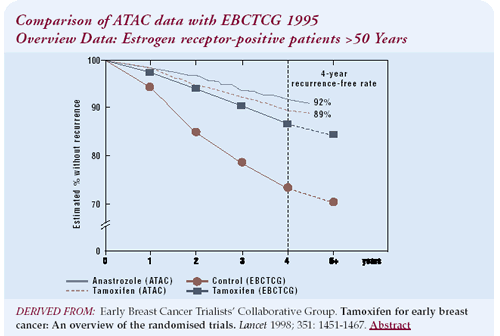|
You
are here: Home: BCU 2|2003: Editor's
office

 |
Editor’s Note |
|
| Candor with Humility |
“I'm not an eccentric maverick in my beliefs, and
I'm not alone. The difference
between most people and me is that I’ve never been frightened
to speak my mind.
Speaking out against mammography does not make you popular.”
— Michael Baum, ChM, FRCS |
As Michael Baum began his William McGuire lecture at the San Antonio
Breast Cancer Symposium, there was no doubt in my mind that at some
point, he would challenge the audience’s belief in a long-held
concept. In the last issue of Breast Cancer Update, Gabe Hortobagyi
mentioned Baum’s 1982 presentation in Jasper, where with only
two years of follow-up for the classic NATO trial, he boldly predicted
that tamoxifen would soon become standard of care for adjuvant therapy.
Over the years, in journal articles, meeting presentations and interviews
for this series, Dr Baum has always pushed us to critically evaluate
long-held paradigms and beliefs. In his San Antonio presentation
— as he states in this interview — he “dared to
challenge the Holy Grail of mammography,” suggesting the possibility
that in some patients, unnecessary biopsy can perturb and stimulate
otherwise indolent tumors. His comments were grounded in science
and clinical experience, but, undoubtedly, many attendees took great
exception to his challenge of not only the medical rationale but
also the ethics of current breast cancer screening practices in
the United States.
One of the privileges of editing this series is the opportunity
to develop longstanding relationships with “movers and shakers”
in clinical research. It has been surprising to see how often these
people are humble at heart, and Mike Baum is no exception. Last
year, I met with him shortly after he presented perhaps the most
important initial data set in the recent history of breast cancer
research — the ATAC adjuvant trial. During our interview,
he was totally at ease, and rather than promote his own role in
designing and launching this historic study, he emphasized the dedication
of the women who chose to enter the trial. Interestingly, Dr Baum
also was very conservative in his approach to translating the data
to clinical practice. It was not until recently, one year later
with further follow-up, that he began to fully support the use of
anastrozole as the first option for adjuvant therapy for postmenopausal
women with receptor-positive invasive breast cancer.
I queried a number of research leaders about Dr Baum’s comments
on breast cancer screening in San Antonio, and most disagreed with
the notion that data supports the potentially deleterious effect
of mammography on the biology of the disease.
However, there was near universal agreement with Dr Baum’s
insistence that clinical research on breast cancer screening be
held to the same standard as treatment trials. It is also difficult
to argue with Dr Baum’s demand that the primary care community
inform women about the risks and benefits of mammography before
they undergo the procedure.
It is quite unlikely that further randomized trials of mammography
will be conducted, and as is often the case in clinical practice,
we will be left with an imperfect data set from which we must base
decisions and recommendations. In that regard, it is interesting
to consider a very striking graphic that was presented by Aman Buzdar
in San Antonio comparing the ATAC trial results to the most recent
findings from the tamoxifen versus control disease-free survival
curves from the international breast cancer overview.
 |
 |
Dr Buzdar’s point is that the ATAC study’s data on
tamoxifen overlaps the overview data (with anastrozole demonstrating
an advantage over both), but within this graphic is a key message
about current clinical research. There were more postmenopausal
women with estrogen receptor-positive breast cancers in the ATAC
trial than there were in the entire international overview of randomized
trials of tamoxifen given for five years. Through more than 30 years
of randomized trials in breast cancer, we have learned that the
most effective way to avoid controversies like the one we see with
mammography is to conduct very large, well-designed studies that
will help lead to clear cut answers and clinical recommendations.
—Neil Love, MD
|
|
